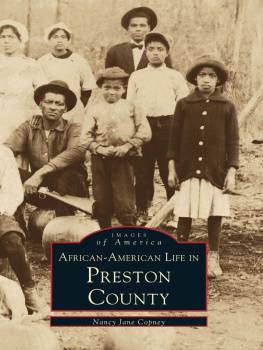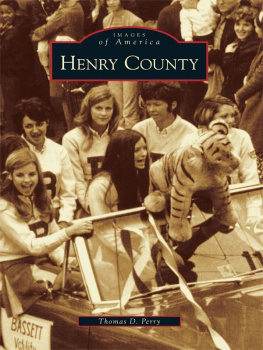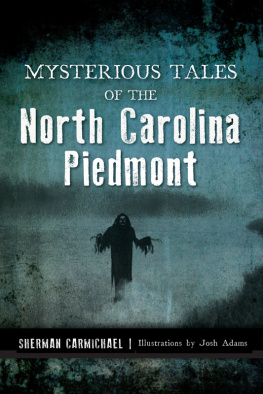Foreword
T HE COUNTY is named Warren for the Massachusetts soldier-doctor who died fighting for American independence at Bunker Hill, and it is an irregular rectangle, twenty miles broad from east to west by somewhat longer at its longest north to south, in the northeastern patchwork of North Carolinas counties. Up against the boundary of Virginia it nestles, remembering when William Byrd and his companions squabbled over the line. To the east it borders on two counties older than itself but not more individual, Northampton and Halifax. To the south is Franklin County, the other half of colonial Bute, which was cut in two midway through the War of Independence. The stretch of Vance County at the western edge was pared from Warren during the nineteenth century.
As a county, Warren is one hundred and eighty years old. Its first white settlers arrived three quarters of a century earlier. Today its population is rather less than 25,000, of which two-thirds are Negro and some, proud claimants of Indian descent. Most of the residents are Warren-born and Warren-bred. Some of them bear names that rang like bugles in the mighty past, when Warren was the center of culture, manners, gallantry, and political leadership for the entire State and in these qualities awed even those self-confident Virginia neighbors across the line to northward.
Gently rolling fields with broad bottom lands are cross-hatched with ancient streams. The Roanoke River brackets the northeast corner of Warren County like a chevron drawn upon the upper quartering of a heraldic coat-of-arms. The creeks have names to catch the ear and imagination, to live in the memory. They are Sixpound and Stonehouse and Shocco; they are Fishing and Little Fishing, Deep and Little Deep; they are Hubquarter and Possumquarter and Nutbush and Hawtree; they are Terrapin and Lizard and Reedy and Rocky; they are Walkers and Dowtins and Phoebes and Lees and Bens and Dicks. The ancient forest of massive hardwoods and mast-high pines was chopped and sawed away long ago, but a sturdy second growth has risen to replace it on more than half of Warren Countys 443 square miles. Post oaks and red oaks and black oaks and white oaks grow larger each year. Old-field and shortleaf pines flourish, and hickories, maples, tulip poplars, and, where the ground is swampy, gums. Sassafras has achieved its stubborn roothold and shows its weird diversity of leaves. In the springtime, redbud and dogwood undergrowth splash the rich greenery with colors. Holly bushes speak of winter festival, but the winters are short and mild; the growing season is 209 days long, from early April to the end of October.
On the many farms, great and small, corn is by far the largest crop, but tobacco is the most profitable, and after tobacco, cotton, and after cotton, cucumbers. County farmers also grow peanuts, potatoes, soy beans, peas, and hay. There are apples and peaches and berries and melons and collards. Fourteen percent of the countys area is given over to pasture for dairy and beef cattle. Hogs and chickens and eggs go to market. Here and there, abandoned fields are tussocked with broom sedge and briar, with young pines hopefully vanguarding the return of the prehistoric wilderness, and the wildflowers that have heralded the returning springs of immemorial ages.
Early leaps up jack-in-the-pulpit. Dogtooth violets and Turks cap lilies bloom, and ninety other flowers follow thesecranes bill, pink ladys slipper, bee balm, toadflax, coral honeysuckle, the various asters and daisies and mulleins. In soggy stretches of ground sprout cattails, marigolds, and the snake-headed pitcher plant. There is the mandrake, a plant once credited with magical healing properties. The country names of other growths recall the times when they were used to comfort the sickself heal, wintergreen, and pleurisy root. St. Johns wort, that a century ago was a charm against evil spirits, is there. Mountain laurel thrives though far from the mountains. Rabbit tobacco tempts each new generation of boys to load experimental pipes. Not until the frost returns in the winter is there a Warren County meadow free from wild flowers.
Warrenton, the county seat, has a population of less than 1,500, including some of the proudest and most resolutely individual men and women in all the region. Pride informs their ready courtesy; and this pride is no empty vanity, nor yet a frantic insistence on shakily founded traditions. For Warrenton is an enduring monument to its own ancient greatness.
A visiting antiquarian has called Warrenton a casket of architectural jewels. Big houses and small endure on its streets, much as they were built by men of taste and sense more than a century ago, and they hold the memories of mighty namesPolk, Macon, Bragg, Johnson, Eaton, Mordecai, Hawkins, Turner, Arrington, Alston, Montgomery, Plummer, and a score and more of others. It has been pointed out that only one of all these old houses, picturesque and beautiful, is occupied today by the heirs of its builder. But the heirs of other houses are still in Warrenton, and when they knock at the doors of their ancestral homes, the doors are opened to them by friendly neighbors who bid them welcome.
There are other towns. Busy Norlinas name telescopes the name of the State once ruled from Warren County. Macon is small, but it echoes the surname of the greatest North Carolinian of his time and of decades beyond his time. Liberia is called, not for the West African principality, but for the spirit of liberty; and Wise, insists tradition, for the spirit of wisdom. Dear to Warren County hearts are place names like Thrift Hill, Old Bethlehem, Dewberry, Greenback, Lickskillet celebrated by rustic mirth, and Shady Grove immortalized by rustic song.
Not idly do those who live in the towns and on the farms hold their possession of their county. The land had to be won and made good and great and beautiful. Twice in other years its sons, with a unanimity of courage and spirit, fought to defend its soil, and twice more they went to fight beyond the sea for Warren County as much as for the whole nation. It is a home region inspirited with a sort of lofty loveliness, like the en chanted princess of knightly dreams, like the proud beauty of romance who is the reward of valor and honor.
Warren County is prosperous; there are twenty sawmills, there are forty dairies, and there are cotton gins and textile mills and banks. Warren County is politely bred; there are ancient churches of various persuasions, there is a newspaper with a brilliant literary tradition, and there are organizations for culture and mannerly association and progress. But, most of all, Warren County is historic; those who live there look keenly backward to a vigorous and glorious past, and without a past there can be no present and no future.
Proper grateful recognition of all who have helped to complete this history would be impossible within the limits of available space; but it must be said at once that no history at all would have been written without the sustained support of the Warren County Historical Society, and, in particular, of its able and energetic president Mr. W. Lunsford Long, himself an intelligent student of the history of his home region. Mr. Long and his group were tireless in the securing and evaluating of historical source material, in the settling of vexing questions as to true facts, and in critical reading of the manuscript at various stages.







